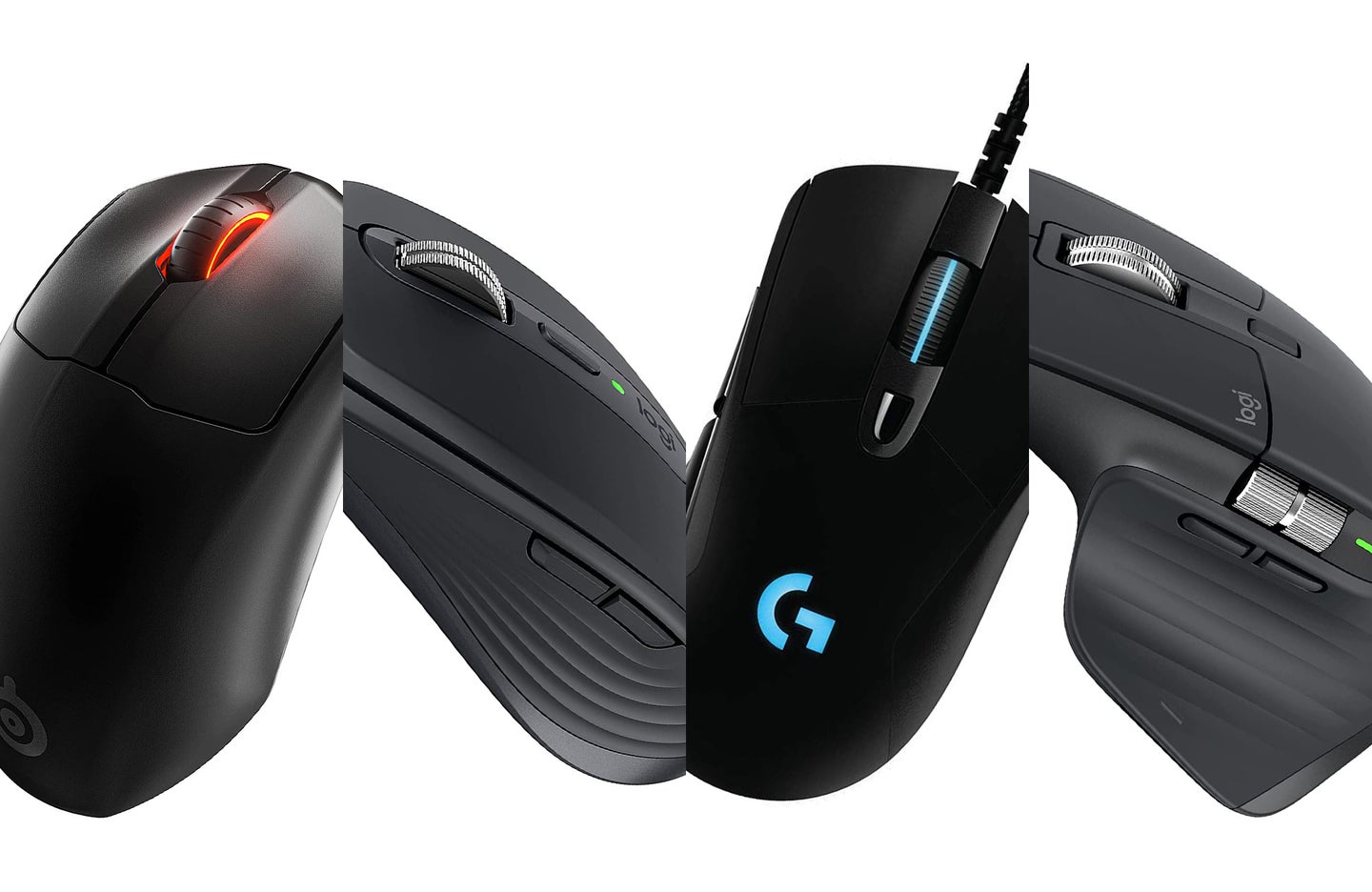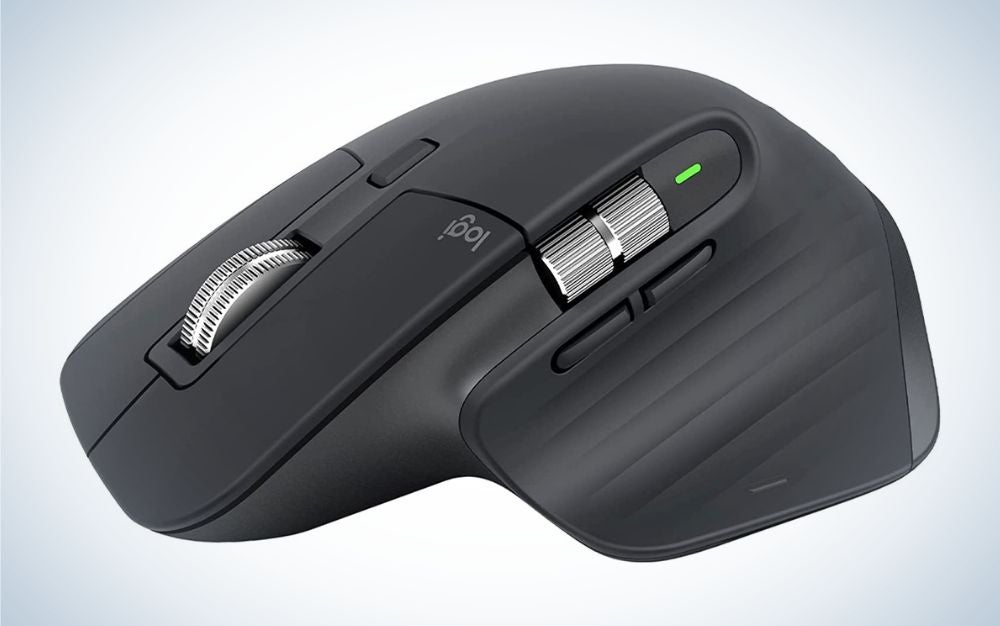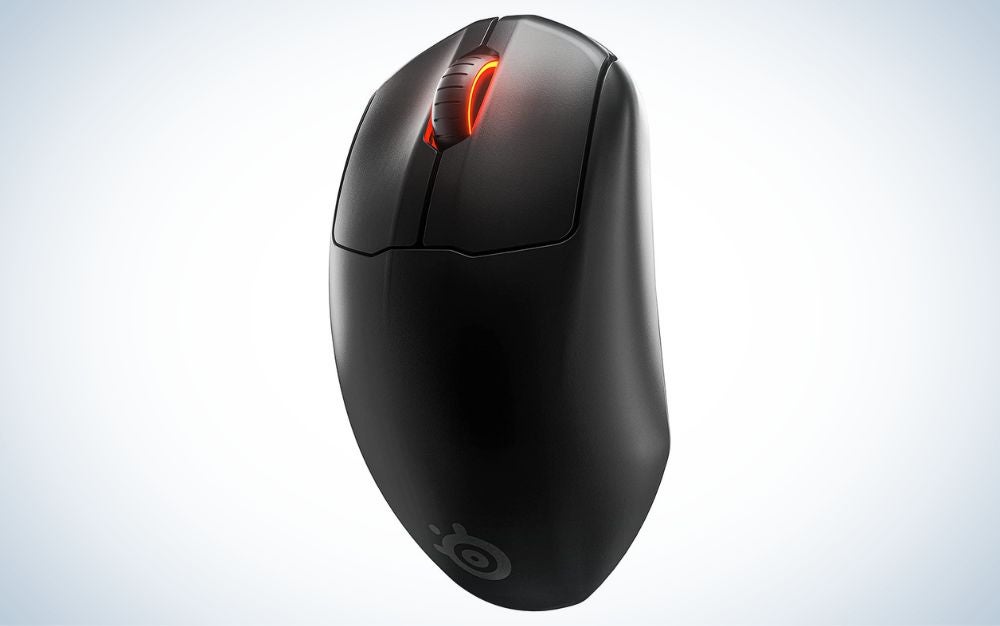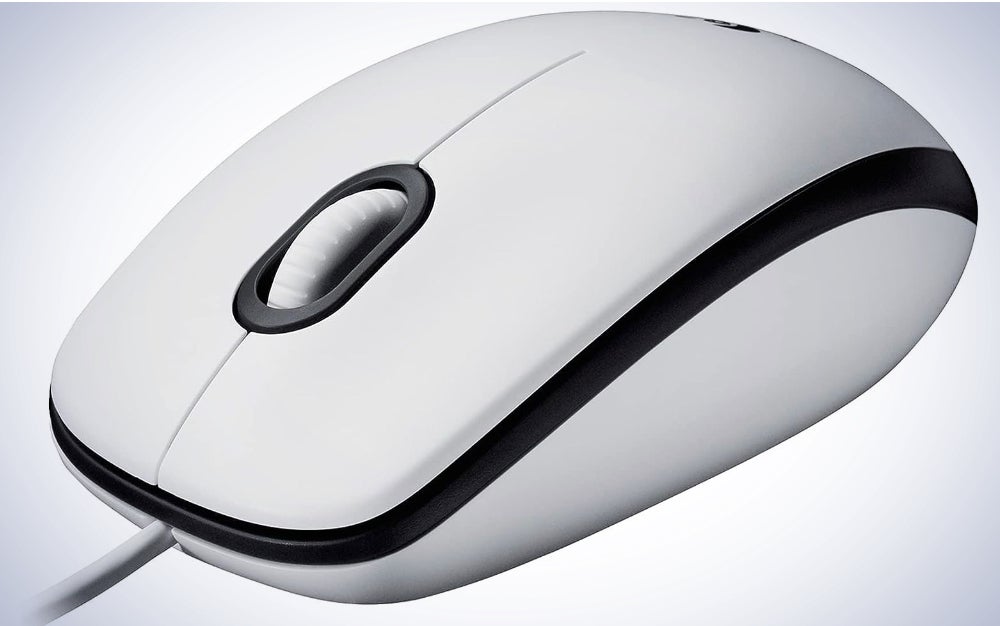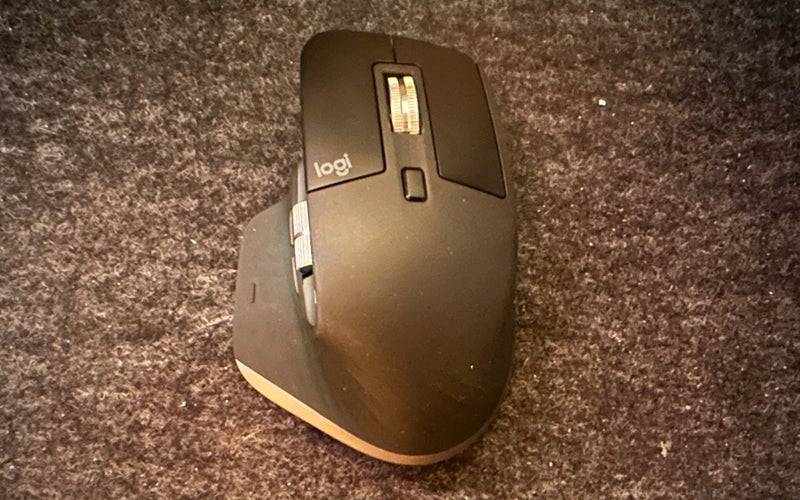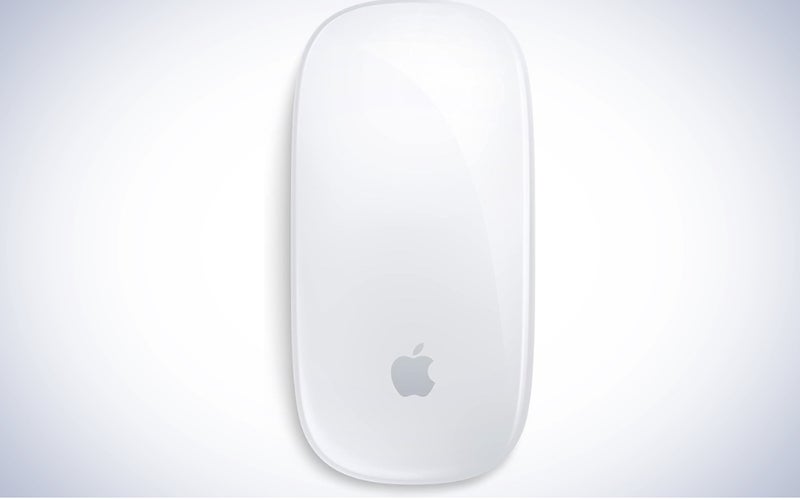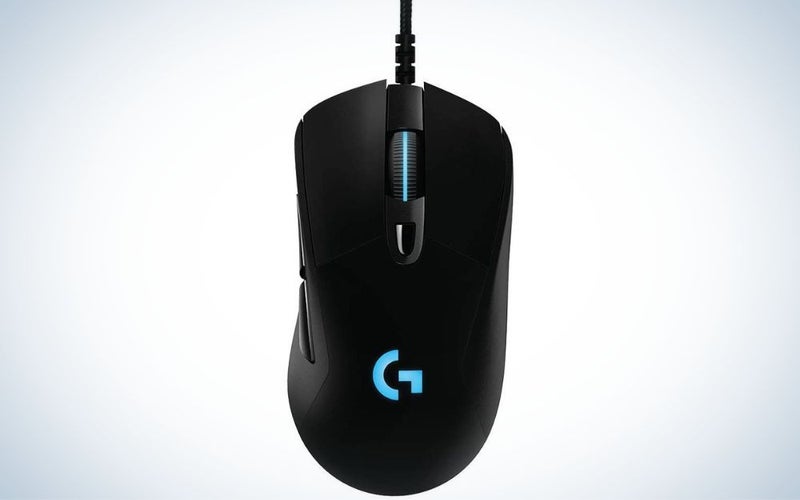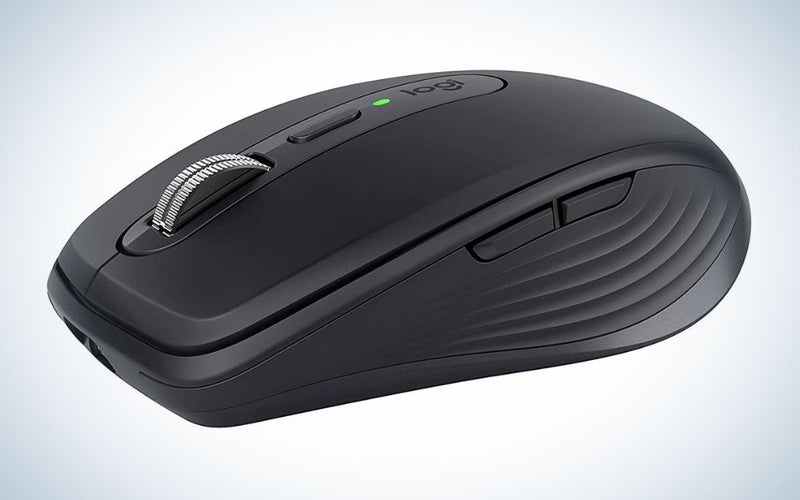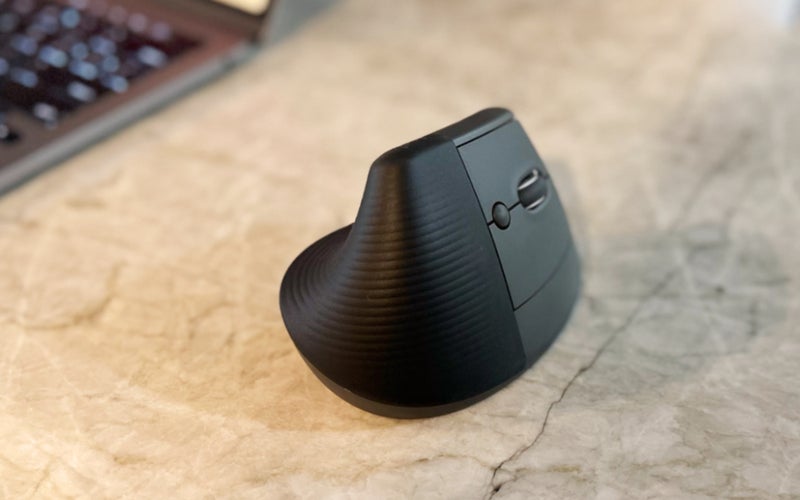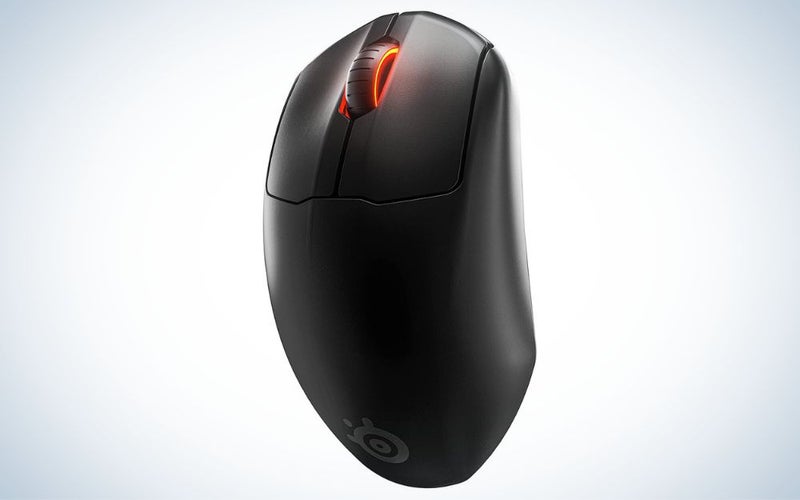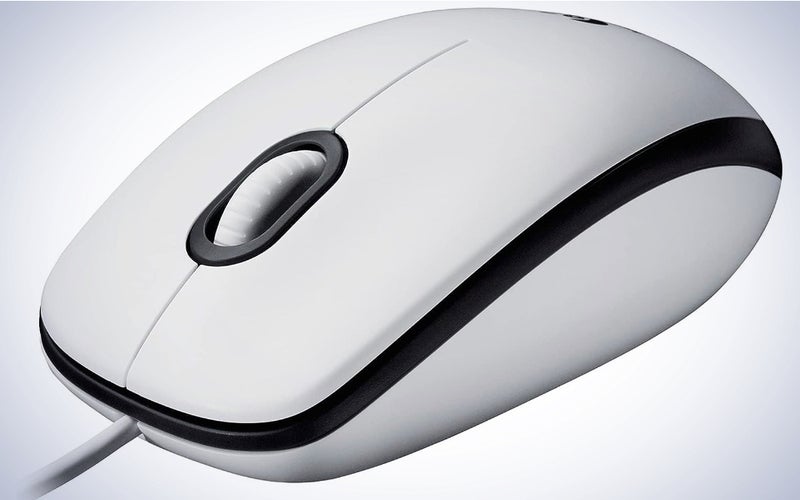We may earn revenue from the products available on this page and participate in affiliate programs. Learn more ›
MacBook trackpads are some of the best around, but it’s hard to beat the precision and comfort of a mouse. Mice provide greater control, improving productivity, and much more comfort over long sessions. Though Mac users often run to Apple’s products first—in this case, the Magic Mouse—we think it is important for you to know there are lots of other options out there. And many of them offer more functionality. Do you want something with multiple buttons that you can program? A gaming mouse with superior customization options? The best mouse for Mac comes in all shapes and sizes, and we want to help you find yours.
- Best overall: Logitech MX Master 3S
- Best Apple mouse: Apple Magic Mouse
- Best wired: Logitech G403
- Best portable: Logitech MX Anywhere 3S
- Best ergonomic: Logitech Lift
- Best gaming: SteelSeries Prime Wireless
- Best budget: Logitech M100
How we chose the best mouse for Mac
I’ve used a MacBook Pro for over 10 years and tested a lot of mice in that time. I know how important a mouse is for a steady workflow, and how frustrating it can be to feel stuck with something you don’t like. Over the years, I’ve tested and reviewed all kinds of mice, from gaming mice to pocket-sized travel mice, for publications like Gear Patrol, CNN Underscored, and Popular Science. I combined that experience with fellow Apple enthusiasts’ suggestions, general user impressions, and research into features and specs to come up with my picks for the best mouse for Mac users of every type.
The best mouse for Mac: Reviews & Recommendations
Laptop or desktop, with Macs for students or for business, you should use a mouse whenever you can. It’s more comfortable, more precise, and can improve your daily workflow. We’ve pulled together a list of the best mice for Mac users, whether you need something to make you more productive, compete in multiplayer games, or just want something comfortable. There’s a little something for everyone.
Best overall: Logitech MX Master 3S
Brandt Ranj
Buy it used or refurbished: eBay
Why it made the cut: The MX Master 3S features deep customization, a terrific scroll wheel, and a comfortable design.
Specs
- Dimensions: 4.92 x 3.32 x 2.01 inches (HWD)
- Weight: 0.31 pounds
- Style: Wireless
- DPI: 200-8,000 (can be set in increments of 50)
- Battery life: Up to 70 days on a full charge
Pros
- Comfortable design
- Extensive customization
- Fantastic battery life
Cons
- No left-handed model
We’re typically fans of Logitech accessories in general, and the Logitech MX Master 3S was the best ergonomic mouse we’ve tried, earning it a spot here. It features a comfortable hybrid design, flexibility, multitude of productivity-enhancing features, and it lasts up to 70 hours per charge. When it does run low, one minute of charging will get you three hours of use. Our favorite physical design features were the MX Master 3S’ dedicated thumbwheel and controls above the thumb rest, which offer superior flexibility while demanding little hand movement.
This mouse may look intimidating at first, but it felt immediately natural in the hand during our tests. As a bonus, its buttons were extremely quiet—so much so that we can recommend this mouse for office use. Its scroll wheel moves along with satisfying, incremental clicks. Initially, we didn’t know what to make of the thumb wheel but found it helpful while working in image editing applications, which is when horizontal scrolling was most helpful. Photoshop, Illustrator, and InDesign users will find this feature indispensable.
One of the most convenient features of the MX Master 3S is the ability to pair it with up to three Bluetooth devices. A recessed button on the bottom of the mouse allows you to easily switch between connections, but it will never get pressed accidentally during regular use. We used the mouse with both our personal and work laptops and switched between them without seamlessly. The biggest surprise we found while testing this mouse was the usefulness of Logitech’s Logi Options+ software, which let us designate a specific function to the mouse’s scroll wheel click and side buttons. Accessing core system features without taking our hand off the mouse was a huge time saver.
Logitech’s MX Master 3S is an ergonomic triumph and a powerful, precise instrument we could recommend to anyone looking for a wireless mouse for creative work. Plus, it pairs beautifully with a top pick in the best keyboards for Macs.
Best Apple mouse: Apple Magic Mouse
Apple
Why it made the cut: Apple’s Magic Mouse is a simple-looking but technically advanced option for those who’re used to multitouch gestures on other Apple hardware.
Specs
- Dimensions: .85 x 2.25 x 4.47 inches (HWD)
- Weight: 0.22 pounds
- Style: Wireless
- DPI: 1300 (can be set in increments of 50)
- Battery life: Up to 90 days on a full charge
Pros
- Touch-sensitive top
- Curved design
- Also works with iPad
Cons
- Cannot be used while charging
Apple’s own Magic Mouse has advantages over third-party mice, especially if you also spend time working on an iPad. The low-profile mouse has a curved top, which contours to the hand, and a pair of buttons whose functionality can be customized in macOS. More importantly, the entire top section of the mouse is a touch screen, which allows you to use gestures to accomplish certain tasks. Swiping up and down will scroll your screen, double-tapping will zoom into a section of your screen, double-tapping with two fingers will bring up mission control, swiping with two fingers will allow you to swipe between full-screen apps, and swiping with one finger will swipe between pages. These gestures can be disabled in MacOS, but leaving them can be handy as it makes getting around the operating system easier. Speaking of operating systems, the Magic Mouse was designed to work with both iPadOS and macOS, which is helpful if you use both recreationally or to get work done. Our chief complaint with the Magic Mouse is that its Lightning charging port isn’t USB-C and is located on the bottom of the mouse, so you can’t use it while it’s being charged.
Best wired: Logitech G403
Logitech G
Buy it used or refurbished: eBay
Why it made the cut: The Logitech G403 provides users with robust customization, long-lasting comfort, and the ability to adjust the mouse’s weight.
Specs
- Dimensions: 4.88 x 2.68 x 1.69 inches (HWD)
- Weight: 0.19 pounds
- Style: Wired
- DPI: 200-12,000
- Battery life: N/A
Pros
- Six programmable buttons
- Onboard memory means you can take settings with you
- RGB lighting
- Adjustable weight
Cons
- Some might find it too flashy as an everyday mouse
The Logitech G403 is a simple, six-button gaming mouse that’s perfect for any kind of computing. Its understated design, deep customization, and ergonomics work just as well for work as they do for play. With rubberized grips for improved grip and control, Mac-compatible configuration software, and an adjustable weight system, the G403 gives you lots of room to customize how your mouse feels so that you have precise control. Whether gaming or working in spreadsheets, Logitech G403 provides users with a robust, highly customizable experience.
Best portable: Logitech MX Anywhere 3S
Logitech
Buy it used or refurbished: eBay
Why it made the cut: The MX Anywhere 3’s compact design and powerful features make it the perfect portable option.
Specs
- Dimensions: 3.96 x 2.56 x 1.35 inches (HWD)
- Weight: 0.21 pounds
- Style: Wireless
- DPI: 200-4,000
- Battery life: Up to 70 days
Pros
- Compact, comfortable design
- Extensive customization
- Excellent scroll wheel
Cons
- Side buttons aren’t suited for left-handed use
- Not as comfortable as a full-size mouse, especially for people with large hands
Logitech’s MX Anywhere 3 features a compact design that doesn’t feel like a compromise. The conventional six-button mouse is small enough to fit in a shirt pocket but large enough to provide some support for your hand. Like the MX Master 3S, it offers many Logitech “MX”-level features, including the ability to connect with up to three devices over Bluetooth and a USB dongle, plus a sensor that can track on glass. If you’re hitting the road this summer, the MX Anywhere 3 is the mouse you want for your Mac.
Best ergonomic: Logitech Lift
Brandt Ranj / Popular Science
Buy it used or refurbished: eBay
Why it made the cut: The Logitech Lift vertical mouse prioritizes comfort and ergonomics without sacrificing features.
Specs
- Dimensions: 2.8 x 2.7 x 4.25 inches (HWD)
- Weight: 0.27 pounds
- Style: Wireless
- DPI: 400-4,000
- Battery life: Up to two years (single AA battery)
Pros
- Vertical design puts your hand in a more natural posture
- Customizable buttons
- Excellent battery life
Cons
- No rechargeable battery
The Logitech Lift is a vertical ergonomic mouse that allows you to control your cursor without twisting your wrist to lay your hand over it. This reduces wrist strain by having your hand posture in a more natural position, reducing pain induced by repetitive strain injuries. It isn’t quite as feature-rich as the MX Vertical, but the Lift is a good starting point and offers up to two years of battery life off a single AA battery (or consider a rechargeable one). The Lift is also one of the few mice available in not only a right-handed form but also a left-handed orientation, making it accessible to everyone.
Best gaming: SteelSeries Prime Wireless
SteelSeries
Buy it used or refurbished: Amazon, eBay
Why it made the cut: Featuring a durable design, great battery life, and support for multiple grip styles, the SteelSeries Prime Wireless is a great gaming mouse for Mac.
Specs
- Dimensions: 4.93 x 2.67 x 1.66 (HWD)
- Weight: 0.17 pounds
- Style: Wireless
- DPI: 100-18,000
- Battery life: Up to 100 hours
Pros
- Sleek, simple design
- Supports multiple grip styles
- Durable
Cons
- Expensive
If you plan to play competitive games on your iMac or MacBook Pro, the SteelSeries Prime Wireless will provide you with the precision and accuracy necessary to defeat your opponents. This gaming mouse was designed in collaboration with 100 esports pros, featuring 18,000 DPI and a lag-free experience that promises up to 100 hours of battery life on a full charge. The SteelSeries Prime Wireless has also been designed to accommodate both standard “palm” grips and gaming-focused “claw” and “tip” grip styles and features mouse switches rated to work for up to 100 million clicks. And when you’re not gaming with the Prime, you can customize the device’s buttons to fit with your workflow.
Best budget: Logitech M100
Logitech
Buy it used or refurbished: eBay
Why it made the cut: Logitech’s M100 offers a simple, straightforward experience at an affordable price.
Specs
- Dimensions: 4.45 x 2.44 x 1.5 inches (HWD)
- Weight: 0.19 pounds
- Style: Wired
- DPI: 1,000
- Battery life: N/A
Pros
- Simple design
- Ambidextrous
- Doesn’t need batteries or charging
Cons
- Very basic
For a simple plug-and-go experience, the Logitech M100 offers a great design at an affordable price. It doesn’t feature the extra buttons of our other picks and can’t be customized, but it provides users with a familiar experience that’s precise, fast, and accurate. It’s also ambidextrous, so it will feel comfortable whether you’re a left-handed or right-handed user. The only problem you might run into is that the M100 connects via USB-A port, which many newer MacBook Pro and MacBook Air laptops don’t have (and check out our thoughts on the latest MacBook Air, the M3). In that case, you might want to consider purchasing a USB hub to get connected.
What to consider when picking the best mouse for Mac
A good mouse should feel comfortable and accurate. You should be able to hold the mouse for a long time, moving the mouse quickly and smoothly across most surfaces without losing track of your cursor. You can plug in or connect almost any mouse to a Mac and start using it right away, but many high-end mice require configuration software to take full advantage of their features, so make sure your mouse plays nice with Mac.
Most Mac users should prioritize wireless mice since most Macbooks made in the last few years have very few ports. In that case, it should offer good battery life and provide a consistent connection.
Wired or wireless?
Before you choose a wired or wireless mouse, you must understand the pros and cons of each setup. Wireless mice are generally more versatile and convenient because they allow users to move quickly from home office to coffee and can pair with multiple devices simultaneously. Wired mice, on the other hand, are typically tethered to a single work or home desktop and may not always be convenient to unplug, so they’re not suited for travel.
However, wired models provide guaranteed stability and less input lag, particularly compared to cheap wireless mice. You also don’t need to wonder about charging or replacing batteries when using a wired mouse, although the battery life of most wireless mice is excellent and shouldn’t be an issue if you charge it weekly.
The best wireless mice generally connect to your computer via a 2.4GHz wireless dongle, which requires a USB connection. In a few cases, you can find a mouse with a USB-C dongle, which is perfect for a MacBook, but users looking for the best possible performance may still find themselves reaching for a USB hub.
We recommend most Mac users get a wireless mouse. Aside from the 2021 MacBook Pro, most recent Mac models only offer a handful of USB-C ports, so connecting a wireless mouse over Bluetooth is the easiest connectivity option. At this point, wireless mice provide close to equal performance to wired mice, particularly outside of gaming.
Comfort
The mouse you buy should feel comfortable all day long. Mice designed with ergonomics in mind support your hand, so you don’t need to grab it or extend your fingers to reach their various inputs. They also allow you to hold your arm in a more natural posture. A poorly designed mouse will feel flat and feature hard-to-reach buttons that force you to shift your hand on the mouse to reach them.
If you can, test out a mouse before you commit to a specific model. Your preferred size, weight, and mouse shape may vary. A few minutes of testing is no replacement for hours of use, but it can still give you an idea of how a mouse’s shape fits in your hand.
Buttons and software
Mice come in all kinds of configurations. Most center around the standard “five-button” format: Left- and right-click panels, two side buttons, and a central button (often in the form of a clickable scroll wheel). That said, some high-end mice offer as many as 10 to 12 buttons, giving you the option to program frequently used keyboard inputs onto your mouse. These more feature-rich mice are often coveted for gaming, but also appear on productivity mice designed for creative workflows and “power users” who want to optimize their PC workflow.
Regardless of how many inputs they have, gaming mice and high-end productivity models usually support a configuration app designed by the manufacturer, which allows you to customize what each button does. These features boost productivity and allow users to create an experience tailored to their workflow. If you buy a mouse that relies on one of these apps, you should check to ensure its configuration software runs on macOS. Many popular mouse brands, particularly those focused on gaming, do not offer macOS versions of their apps.
Mouse sensor
Virtually all modern mice feature an optical sensor on the bottom, which tracks the mouse’s movement so your on-screen cursor can match it. Optical sensors use a small LED light and a photo sensor to look for even the smallest changes in the surface underneath your mouse. Your mouse updates cursor placement on-screen based on your movements.
Not all mouse sensors are created equal, though almost any mouse made by a major manufacturer should be well-equipped for everyday work and web browsing. Broadly speaking, a better mouse sensor offers a more responsive experience and the ability to fine-tune your control. Some cheaper sensors may have a hard time on certain surfaces, such as glass. You may also find that better sensors are less likely to lose track of your mouse when you pick it up to move it.
On a more granular level, mice with “powerful” sensors will offer better, more customizable tracking. You will see that primarily through the mouse’s maximum cursor speed or “sensitivity,” which allows you to adjust how far your cursor moves when you move your mouse. Sensitivity is measured in “dots per inch” (DPI), which tells you how many pixels your cursor will span when you move your mouse 1 inch. The vast majority of mice offer a high-enough max DPI for any standard-size monitor, but it can be helpful to look at as an indication of general sensor quality. There’s a wider range of mouse sensor specs that measure its ability to track your mouse’s movement, but they’ll only help the most discerning competitive gamers.
FAQs
Q: Are all mice compatible with Mac products?
Mice are generally platform-agnostic. Technically, you can connect any mouse, and it should just work on a basic level. That said, many mice support configuration software that allows you to take full advantage of their features, and not all manufacturers make their apps available on macOS. We can’t recommend buying a mouse if you won’t have access to its full functionality.
Also, some mice are designed to integrate with specific features within a platform. For example, Logitech offers a version of its excellent MX Master 3 for Mac, which integrates more deeply with devices like the MacBook Pro.
Q: What’s the difference between a Magic Mouse and a normal mouse?
Apple’s Magic Mouse is … a unique device. As a first-party Apple peripheral, it integrates seamlessly with Mac devices, and its sleek look matches many Apple computers. At the same time, the Magic Mouse’s minimalist design creates some confounding flaws.
The Magic Mouse’s top surface is very flat and allows you to set different inputs for clicking on the left or right side, as well as using swipes, pinches, and tapping. No other mouse does that quite the same way. However, that flat surface isn’t particularly comfortable for conventional mouse use. Meanwhile, it lacks side buttons and features a charging port on the underside of the mouse, preventing you from using it while charging.
Candidly, we think there are better options for Mac users unless you have your heart set on buying an Apple peripheral to go with your Apple computer.
Q: Is a wired or wireless mouse better?
Picking between a wired and wireless mouse often comes down to convenience. At this point, most wireless mice provide a stable connection without introducing a noticeable amount of additional input lag outside of gaming. A wireless mouse cuts the cord but introduces some maintenance. A wired mouse means you don’t have to worry about charging or losing a dongle.
For Macs, especially modern Mac laptops with only a couple of USB-C ports, we recommend looking for a wireless mouse so you can avoid using a USB hub to connect it.
Final thoughts on the best mouse for Mac
- Best overall: Logitech MX Master 3S
- Best wired: Logitech G403
- Best portable: Logitech MX Anywhere 3
- Best ergonomic: Logitech Lift
- Best gaming: SteelSeries Prime Wireless
- Best budget: Logitech M100
Mac users have dozens of quality mice options that range in size, features, and price. The hard part is wading through the multitude of choices and finding the one that works best for you. Our picks above provide a good jumping-off point for every type of user, whether you want something ergonomic or portable. Whatever you choose, make sure it offers the features that fit into your workflow and, most importantly, is comfortable to use over an extended period.
Why trust us
Popular Science started writing about technology more than 150 years ago. There was no such thing as “gadget writing” when we published our first issue in 1872, but if there was, our mission to demystify the world of innovation for everyday readers means we would have been all over it. Here in the present, PopSci is fully committed to helping readers navigate the increasingly intimidating array of devices on the market right now.
Our writers and editors have combined decades of experience covering and reviewing consumer electronics. We each have our own obsessive specialties—from high-end audio to video games to cameras and beyond—but when we’re reviewing devices outside of our immediate wheelhouses, we do our best to seek out trustworthy voices and opinions to help guide people to the very best recommendations. We know we don’t know everything, but we’re excited to live through the analysis paralysis that internet shopping can spur so readers don’t have to.
